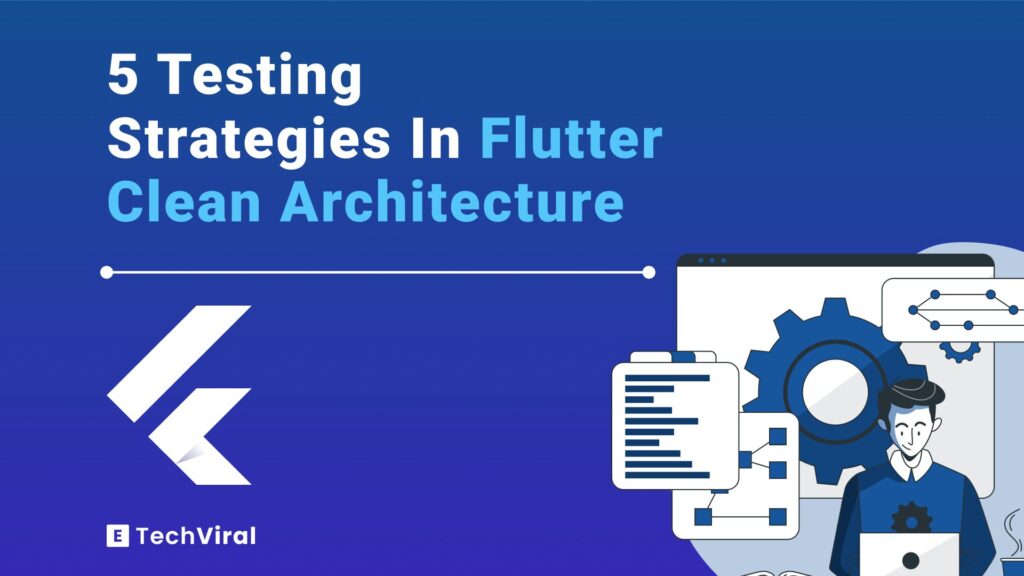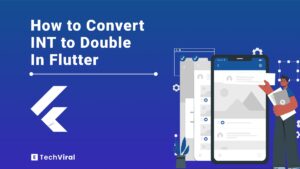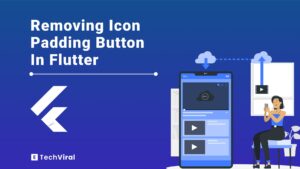Are you a Flutter developer eager to boost your app’s quality through effective testing? Then you should understand that Flutter’s Clean Architecture isn’t just a way to build apps, it’s about doing it the right way. Testing plays a key role here, ensuring your Flutter app is as strong and efficient as it looks.
This is your go-to guide for mastering the testing strategies in Flutter Clean Architecture! We’re not just talking theory, each strategy comes with a real-world example to show you exactly how it’s done. Whether you’re tweaking an app you’ve been working on or starting a new one, these strategies are your go-to tools for building something impressive.
Let’s dive into these approaches and see how they can transform your Flutter development process.
5 Testing Strategies In Flutter Clean Architecture
When you Implement clean architecture in Flutter make sure to use thes strategies to test your app for optimizing and enhancing the performance and reliability of your applications.
1. Unit Testing in Clean Architecture
Unit Testing In Flutter
Unit Testing is a fundamental aspect of software development, focusing on testing individual units of code (like functions or classes) to ensure they work as intended. In the context of Flutter’s Clean Architecture, Unit Testing becomes even more critical as it helps maintain the integrity of each layer in your architecture.
Setting Up for Unit Testing
Before we begin, ensure you have the following setup in your Flutter environment:
- Flutter SDK installed.
- A Flutter project with Clean Architecture implemented.
- The
test packageadded to your pubspec.yaml file.
Step-by-Step Tutorial: Writing a Unit Test
Step 1: Identify the Unit to Test
Choose a Use Case from the Domain layer. For example, FetchUserUseCase.
Step 2: Create a Test File
- In your
testdirectory, create a new test file, e.g.,fetch_user_use_case_test.dart.
Step 3: Write the Test Setup
- Import necessary packages and dependencies.
Create a setup where you mock the dependencies of the Use Case. Assume FetchUserUseCase depends on a UserRepository.
import 'package:flutter_test/flutter_test.dart';
import 'package:mockito/mockito.dart';
import 'package:your_project/domain/use_cases/fetch_user_use_case.dart';
import 'package:your_project/data/repositories/user_repository.dart';
class MockUserRepository extends Mock implements UserRepository {}
void main() {
FetchUserUseCase useCase;
MockUserRepository mockUserRepository;
setUp(() {
mockUserRepository = MockUserRepository();
useCase = FetchUserUseCase(mockUserRepository);
});
}
Step 4: Write Test Cases
- Write different scenarios for testing the Use Case. Start with a ‘success’ scenario where the Use Case retrieves data as expected.
test('should get user data when call to user repository is successful', () async {
// Arrange
when(mockUserRepository.fetchUser(any))
.thenAnswer((_) async => User(id: 1, name: 'John Doe'));
// Act
final result = await useCase(Params(userId: 1));
// Assert
expect(result, equals(User(id: 1, name: 'John Doe')));
});
Step 5: Run the Test
- Execute the test by running flutter test in your terminal.
Common Pitfalls and Best Practices
- Pitfall: Not isolating the unit test. Ensure your unit tests are not dependent on external factors like APIs or databases.
- Best Practice: Use mocking extensively to simulate dependencies.
- Pitfall: Writing overly complex tests. Remember, unit tests should be simple and test only one aspect at a time.
- Best Practice: Keep tests readable and maintainable. If a test is getting too complicated, it might be a sign your code needs refactoring.
2. Widget Testing for UI Components
Widget Testing in Flutter
Widget Testing in Flutter allows developers to test individual widgets in isolation, ensuring that the UI behaves as expected. It’s crucial for maintaining the quality of your app’s user interface, especially when using Clean Architecture.
Preparing for Widget Testing
Make sure you have:
- Flutter SDK and your Flutter project ready.
- The flutter_test package included in your pubspec.yaml.
Step-by-Step Tutorial: Writing a Widget Test
Step 1: Choose a Widget to Test
- Select a widget from your presentation layer. For instance, a UserProfileWidget.
Step 2: Create a Test File
In the test/widget_tests directory, create a new file, e.g., user_profile_widget_test.dart.
Step 3: Set Up the Test Environment
- Import necessary packages and set up a testWidgets environment.
import 'package:flutter/material.dart';
import 'package:flutter_test/flutter_test.dart';
import 'package:your_project/presentation/widgets/user_profile_widget.dart';
void main() {
testWidgets('UserProfileWidget displays correct data', (WidgetTester tester) async {
// Test code will go here
});
}
Step 4: Write the Test
- Implement the widget test, ensuring the widget displays the correct data.
testWidgets('UserProfileWidget displays correct data', (WidgetTester tester) async {
// Arrange
await tester.pumpWidget(MaterialApp(home: UserProfileWidget(user: User(id: 1, name: 'John Doe'))));
// Act - nothing here, as we're only testing the initial state
// Assert
expect(find.text('John Doe'), findsOneWidget);
expect(find.text('User ID: 1'), findsOneWidget);
});
Step 5: Execute the Test
- Run your widget tests by executing flutter test in the terminal.
Common Challenges and Tips
- Challenge: Testing interactive elements. Widgets like buttons may have complex interactions.
- Tip: Use tester.tap() and tester.pumpAndSettle() to simulate interactions and animations.
- Challenge: Handling asynchronous data.
- Tip: Use tester.runAsync() to test widgets that depend on Future responses.
- Challenge: Over-reliance on golden tests. Golden tests compare the rendering of your widgets to saved images, which might not always be practical.
- Tip: Balance golden tests with more functional widget tests that assess behavior over appearance.
3. Integration Testing Across Layers
The Role of Integration Testing in Flutter
Integration Testing is crucial for ensuring that different layers and components of your Flutter application work together seamlessly. In Clean Architecture, this means testing the integration between the Presentation, Domain, and Data layers.
Preparing for Integration Testing
To get started, you will need:
- Your Flutter environment is set up.
- The integration_test package added to your project.
Step-by-Step Guide: Creating an Integration Test
Step 1: Define the Integration Test Scenario
- Choose a feature that involves multiple layers. For instance, a user login process that involves UI components, business logic, and data fetching.
Step 2: Set Up the Integration Test File
- Create a new test file in the integration_test directory, e.g., user_login_integration_test.dart.
Step 3: Write the Integration Test
- Begin by importing necessary packages and setting up the test environment.
import 'package:flutter/material.dart';
import 'package:integration_test/integration_test.dart';
import 'package:your_project/main.dart' as app;
void main() {
IntegrationTestWidgetsFlutterBinding.ensureInitialized();
testWidgets('User login integration test', (WidgetTester tester) async {
app.main(); // Start your app
await tester.pumpAndSettle();
// Further test steps will be added here
});
}
Step 4: Implement the Test Steps
- Simulate user input and interactions, and verify the integration across layers.
// Simulate user input
await tester.enterText(find.byType(TextField).at(0), 'john.doe@example.com');
await tester.enterText(find.byType(TextField).at(1), 'password123');
await tester.tap(find.byType(ElevatedButton));
await tester.pumpAndSettle();
// Assert the outcome
expect(find.text('Welcome, John Doe'), findsOneWidget);
Step 5: Run the Integration Test
- Execute the test by running flutter test integration_test/user_login_integration_test.dart.
Addressing Challenges in Integration Testing
- Challenge: Testing asynchronous operations.
- Tip: Use await tester.pumpAndSettle() to wait for all animations and Future responses to complete.
- Challenge: Handling dependencies like network calls or databases.
- Tip: Mock dependencies or use a testing environment to isolate the test scenario.
- Challenge: Ensuring test reliability across different devices and environments.
- Tip: Run tests on multiple devices and configurations to ensure consistency.
4. Mocking and Dependency Injection
Importance of Mocking in Clean Architecture
In Clean Architecture Flutter, mocking is essential for isolating each layer and component during testing. It allows you to simulate the behavior of dependencies, like APIs or databases, ensuring that your tests are focused and reliable.
Preparing for Mocking and Dependency Injection
Ensure you have:
- A basic understanding of the Clean Architecture layers in your Flutter app.
- The mockito package (or similar) added to your pubspec.yaml for creating mocks.
Step-by-Step Tutorial: Implementing Mocks in Tests
Step 1: Identify Dependencies to Mock
- Choose a component with external dependencies, such as a repository or network service.
Step 2: Create Mock Classes
- Use mockito to create mock classes for the dependencies.
import 'package:mockito/mockito.dart';
import 'package:your_project/data/services/user_service.dart';
class MockUserService extends Mock implements UserService {}
Step 3: Write Tests Using Mocks
- Inject these mocks into the components you are testing.
Use when() to define the behavior of the mock.
test('Should return a user when the call to user service is successful', () async {
// Arrange
MockUserService mockUserService = MockUserService();
when(mockUserService.fetchUser(any))
.thenAnswer((_) async => User(id: 1, name: 'John Doe'));
// Act
var result = await yourComponentThatUsesUserService.getUser();
// Assert
expect(result, isA<User>());
expect(result.name, 'John Doe');
});
Step 4: Implement Dependency Injection
- Use constructor injection to pass mock objects into your components during testing.
- This allows for more flexible and maintainable tests.
Tips for Effective Mocking and Dependency Injection
- Tip: Use verify() from mockito to ensure that the expected methods on mock objects are called.
- Tip: Keep your mock setups as close as possible to the real implementations to ensure realistic test scenarios.
- Tip: Dependency injection not only aids in testing but also enhances the overall design and maintainability of your code.
5. End-to-End Testing and Automation
Overview of End-to-End Testing in Flutter
In the five testing strategies in flutter clean architecture this one is the most important strategy. End-to-End (E2E) Testing is important for verifying the complete flow of an application from start to finish. In Flutter, it involves testing the app as a whole, ensuring that all components work together as expected.
Setting Up for End-to-End Testing
To prepare for E2E testing:
- Ensure you have a stable version of your Flutter app ready for testing.
- Install the integration_test package, a part of the Flutter SDK, which facilitates E2E testing.
Step-by-Step Guide: Creating an E2E Test
Step 1: Define the E2E Test Scenario
- Select a critical user journey to test, such as completing a purchase in an e-commerce app.
Step 2: Write the E2E Test
- Create a new test file in your integration_test directory, e.g., e2e_test.dart.
- Use a real-world scenario for the test to replicate user behavior.
import 'package:flutter_test/flutter_test.dart';
import 'package:integration_test/integration_test.dart';
import 'package:your_app/main.dart' as app;
void main() {
IntegrationTestWidgetsFlutterBinding.ensureInitialized();
testWidgets('Complete purchase flow', (WidgetTester tester) async {
app.main();
await tester.pumpAndSettle();
// Simulate user interactions and test the complete flow
// ...
});
}
Step 3: Run the E2E Test
- Execute the test using flutter test integration_test/e2e_test.dart.
Automation and Continuous Testing
- Automate your E2E tests to run as part of your CI/CD pipeline.
- Use tools like GitHub Actions, GitLab CI, or Jenkins to integrate testing into your development process.
- Regularly update and maintain your E2E tests to match the evolving features of your app.
Challenges and Best Practices
- Challenge: Flakiness in E2E tests due to dependencies on external services or varied environments.
- Tip: Use mock servers or stubs for external services to reduce flakiness.
- Challenge: Keeping E2E tests up-to-date with frequent app changes.
- Tip: Regularly review and update your E2E tests to ensure they reflect the current state of your app.
Conclusion
Testing is integral part of the Flutter development process, especially when using Clean Architecture. This guide has walked you through five key testing strategies in flutter clean architecture which are:
- Unit Testing for verifying individual functions and methods.
- Widget Testing for ensuring UI components render and behave correctly.
- Integration Testing for checking the interaction between different layers.
- Mocking and Dependency Injection for isolating components and making tests more reliable.
- End-to-End Testing for validating complete user journeys.
Adding these testing methods to your development routine will greatly improve your Flutter apps in terms of quality, dependability, and ease of upkeep. Keep in mind, testing isn’t only for catching errors; it’s also crucial for making sure your app provides a smooth and enjoyable experience for its users.
Additional Resources
To further your knowledge and skills in Flutter testing, here are some resources:
- Flutter Official Testing Documentation
- Mockito Package for Dart and Flutter
- Integration Testing with Flutter
Join Flutter communities on platforms like Reddit, Stack Overflow, and GitHub to stay updated with the latest testing practices and solutions.
We encourage you to experiment with these strategies, share your experiences, and continue learning. If you have any questions, insights, or feedback, feel free to leave a comment below. Happy testing!
FAQ’s
How do you ensure that your Flutter app’s security measures are tested effectively in Clean Architecture?
To effectively test security in Flutter’s Clean Architecture, integrate security-focused tests at each layer. For unit tests, mock security scenarios like authentication failures. In integration tests, simulate secure data flow between layers. Use end-to-end tests to validate overall security protocols, including encryption and secure storage. Regularly update tests to cover new security threats.
What are the best practices for managing test data in Flutter Clean Architecture?
Best practices include using mock objects and factories to generate test data, ensuring data is representative of real-world scenarios. Isolate test environments from production to prevent data leakage. Utilize dependency injection to swap real services with mock ones, allowing for controlled test conditions. Regularly review and update test data to reflect changes in the app’s data structures.
How can you automate testing in a CI/CD pipeline for a Flutter app using Clean Architecture?
Integrate testing scripts into your CI/CD pipeline that trigger automated unit, widget, integration, and end-to-end tests on code commits or pull requests. Use tools like GitHub Actions or GitLab CI for automation. Ensure the pipeline includes steps for setting up a Flutter environment, running tests, and reporting results. This ensures every build is automatically tested for quality and stability.
Can you integrate third-party testing frameworks with Flutter Clean Architecture for enhanced testing capabilities?
Yes, you can integrate third-party testing frameworks like Appium or Selenium for enhanced UI and end-to-end testing capabilities. These frameworks can complement Flutter’s testing tools by providing additional features like cross-browser testing or visual regression testing. Use dependency injection to integrate these tools seamlessly with your Clean Architecture setup, allowing for more comprehensive testing strategies.
How do you handle asynchronous operations in testing with Flutter’s Clean Architecture?
Handling asynchronous operations requires careful planning. Use the async and await keywords in your test cases to ensure that asynchronous operations complete before assertions are made. For widget testing, use tester.pumpAndSettle() to wait for all animations and asynchronous events to complete. In integration tests, utilize Future responses and pumpAndSettle to accurately test interactions involving network calls or database operations.











